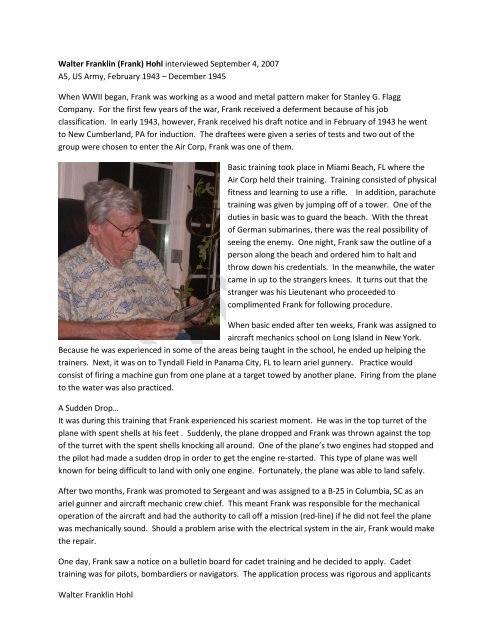Walter Franklin Hohl Walter Franklin (Frank) Hohl interviewed ...
Walter Franklin Hohl Walter Franklin (Frank) Hohl interviewed ...
Walter Franklin Hohl Walter Franklin (Frank) Hohl interviewed ...
Create successful ePaper yourself
Turn your PDF publications into a flip-book with our unique Google optimized e-Paper software.
<strong>Walter</strong> <strong><strong>Frank</strong>lin</strong> (<strong>Frank</strong>) <strong>Hohl</strong> <strong>interviewed</strong> September 4, 2007<br />
A5, US Army, February 1943 – December 1945<br />
When WWII began, <strong>Frank</strong> was working as a wood and metal pattern maker for Stanley G. Flagg<br />
Company. For the first few years of the war, <strong>Frank</strong> received a deferment because of his job<br />
classification. In early 1943, however, <strong>Frank</strong> received his draft notice and in February of 1943 he went<br />
to New Cumberland, PA for induction. The draftees were given a series of tests and two out of the<br />
group were chosen to enter the Air Corp, <strong>Frank</strong> was one of them.<br />
<strong>Walter</strong> <strong><strong>Frank</strong>lin</strong> <strong>Hohl</strong><br />
Basic training took place in Miami Beach, FL where the<br />
Air Corp held their training. Training consisted of physical<br />
fitness and learning to use a rifle. In addition, parachute<br />
training was given by jumping off of a tower. One of the<br />
duties in basic was to guard the beach. With the threat<br />
of German submarines, there was the real possibility of<br />
seeing the enemy. One night, <strong>Frank</strong> saw the outline of a<br />
person along the beach and ordered him to halt and<br />
throw down his credentials. In the meanwhile, the water<br />
came in up to the strangers knees. It turns out that the<br />
stranger was his Lieutenant who proceeded to<br />
complimented <strong>Frank</strong> for following procedure.<br />
When basic ended after ten weeks, <strong>Frank</strong> was assigned to<br />
aircraft mechanics school on Long Island in New York.<br />
Because he was experienced in some of the areas being taught in the school, he ended up helping the<br />
trainers. Next, it was on to Tyndall Field in Panama City, FL to learn ariel gunnery. Practice would<br />
consist of firing a machine gun from one plane at a target towed by another plane. Firing from the plane<br />
to the water was also practiced.<br />
A Sudden Drop…<br />
It was during this training that <strong>Frank</strong> experienced his scariest moment. He was in the top turret of the<br />
plane with spent shells at his feet . Suddenly, the plane dropped and <strong>Frank</strong> was thrown against the top<br />
of the turret with the spent shells knocking all around. One of the plane’s two engines had stopped and<br />
the pilot had made a sudden drop in order to get the engine re-started. This type of plane was well<br />
known for being difficult to land with only one engine. Fortunately, the plane was able to land safely.<br />
After two months, <strong>Frank</strong> was promoted to Sergeant and was assigned to a B-25 in Columbia, SC as an<br />
ariel gunner and aircraft mechanic crew chief. This meant <strong>Frank</strong> was responsible for the mechanical<br />
operation of the aircraft and had the authority to call off a mission (red-line) if he did not feel the plane<br />
was mechanically sound. Should a problem arise with the electrical system in the air, <strong>Frank</strong> would make<br />
the repair.<br />
One day, <strong>Frank</strong> saw a notice on a bulletin board for cadet training and he decided to apply. Cadet<br />
training was for pilots, bombardiers or navigators. The application process was rigorous and applicants
could not apply for a specific job. There were physical and mental tests to take as well as the gathering<br />
of recommendations from school, church and work. In addition, applicants needed an IQ of at least 110.<br />
Testing took place in Miami Beach, FL and consisted of eight hours each of physical, mental and<br />
psychological testing. In the end, <strong>Frank</strong> qualified for pilot and bombardier, and just missed qualifying for<br />
navigator.<br />
Because <strong>Frank</strong> had now qualified for Cadet training, he never<br />
flew with his B-25 crew. A good friend of his, <strong>Frank</strong> Hoffman,<br />
ended up taking his place on the crew. Sadly, the plane crashed<br />
one week after leaving for Europe and <strong>Frank</strong> Hoffman was killed.<br />
A Memorable Time in Chattanooga…<br />
As part of the Cadet program, the next assignment was to<br />
attend the University of Chattanooga in Tennessee. Here, he<br />
attended regular college classes (coed) such as history and<br />
geography and also aeronautics. <strong>Frank</strong> was attending school<br />
just like any other student and was even on the track team as a<br />
miler. In addition, <strong>Frank</strong> learned to fly in an Aeronca training<br />
plane (similar to a Piper Cub). The most notable event,<br />
however, was the wedding of <strong>Frank</strong> and Betty in Chattanooga on<br />
May 20, 1944. From this point on, Betty was able to move from<br />
assignment to assignment with <strong>Frank</strong>.<br />
<strong>Frank</strong> and Betty <strong>Hohl</strong> on their wedding<br />
day. May 20, 1944 in Chattanooga, TN<br />
Now, there was an overflow of cadets and no room in flight school so <strong>Frank</strong> was assigned to Valdosta,<br />
GA along with a group of 18 other cadets who would stay together for the next few assignments.<br />
Because <strong>Frank</strong> was a Sergeant, he was in charge of his own little unit. His job was almost like that of a<br />
Drill Instructor enforcing regulations such as the proper making of a bed and making sure the men<br />
attended mandatory training. One day, the cadets had to go to a lecture. <strong>Frank</strong> stayed back and walked<br />
through the barracks and found that one cadet hadn’t left. It was up to <strong>Frank</strong> to “explain” to him the<br />
importance of attending lectures.<br />
Meanwhile, Betty went to the base personnel office and was hired as a secretary. Part of her job was to<br />
interview civilians who wanted to work on the base. Later, in San Antonio, TX, she took dictation at the<br />
hearings for Cadets who had “washed out” of the program, but were appealing their expulsion. Most of<br />
these cases were due to discipline problems. Later, in Enid, OK, she worked for the officer in charge of<br />
supplies who spoke with a thick southern accent. He would dictate to her which was difficult because<br />
he didn’t pronounce his “r’s.”<br />
One of <strong>Frank</strong>’s fellow cadets was one of the “Doolittle Raiders.” The Raiders were the first Americans to<br />
bomb the Japanese mainland early in the war. All of the planes involved in the mission had to crash land<br />
and not all of them were able to escape from enemy held territory.<br />
The next assignment was Dothan, AL for gunnery school. Here, <strong>Frank</strong> trained other cadets to fire a .45<br />
caliber pistol and to shoot skeet with a shotgun. This assignment lasted for about four months and then<br />
<strong>Walter</strong> <strong><strong>Frank</strong>lin</strong> <strong>Hohl</strong>
he was transferred to the San Antonio Aviation Cadet Center (SAACC) in<br />
Texas. Here, <strong>Frank</strong> had training as a radio operator and in aircraft<br />
identification and Morse code. In addition, he helped to train Chinese<br />
and Brazilian Cadets in small arms firing.<br />
Training in the Cadet program was tough and the instructors were always<br />
looking to wash Cadets out of the program. Failures in certain areas were<br />
grounds for expulsion.<br />
<strong>Frank</strong> <strong>Hohl</strong> in flight gear. 1945 in<br />
Amarillo, Texas.<br />
Because <strong>Frank</strong> had qualified as a Flight Engineer, he was assigned to a<br />
new B-29 in Amarillo, TX. The B-29’s were the newest bombers. They<br />
were pressurized to enable them to fly at higher altitudes. After receiving<br />
training on the B-29, <strong>Frank</strong> took a one week furlough to go home. During<br />
the week at home, the rest of his class was commissioned to continue<br />
with their training, but not <strong>Frank</strong>. He was given the choice to re-enlist or<br />
stop the Cadet training. <strong>Frank</strong> elected to stop the training. By this time,<br />
the war had come to an end. While disappointed that he didn’t get to use<br />
his training, he was glad the war was over. <strong>Frank</strong> received his discharge<br />
on December 12, 1945 in Greensboro, NC.<br />
<strong>Walter</strong> <strong><strong>Frank</strong>lin</strong> <strong>Hohl</strong>





